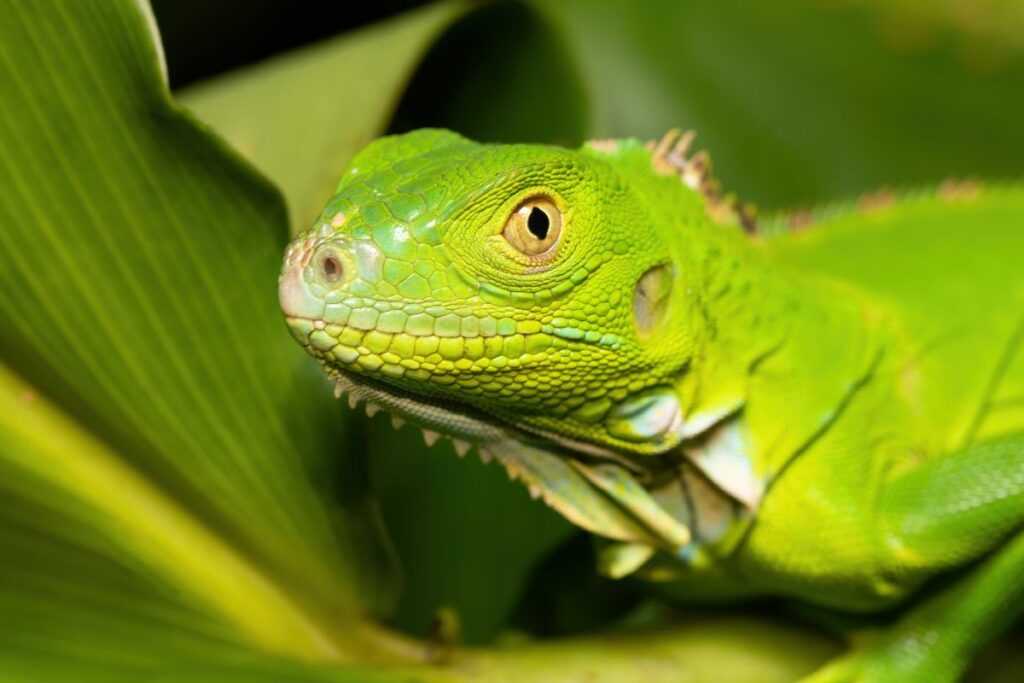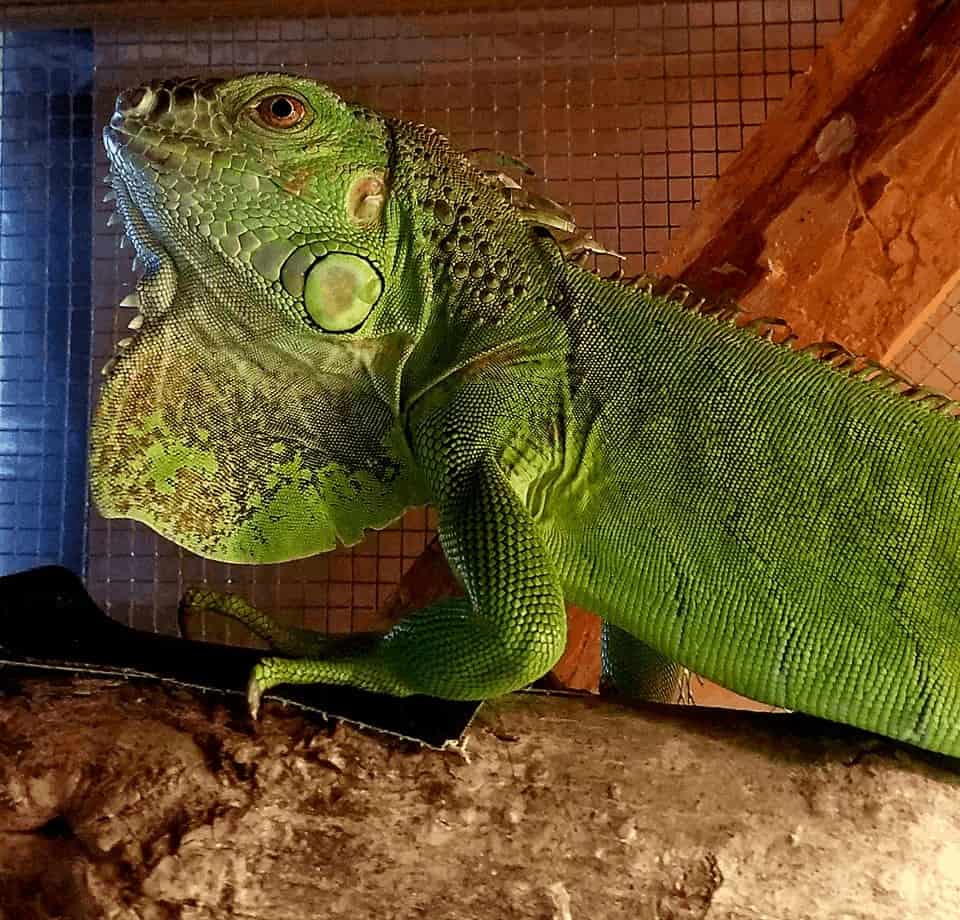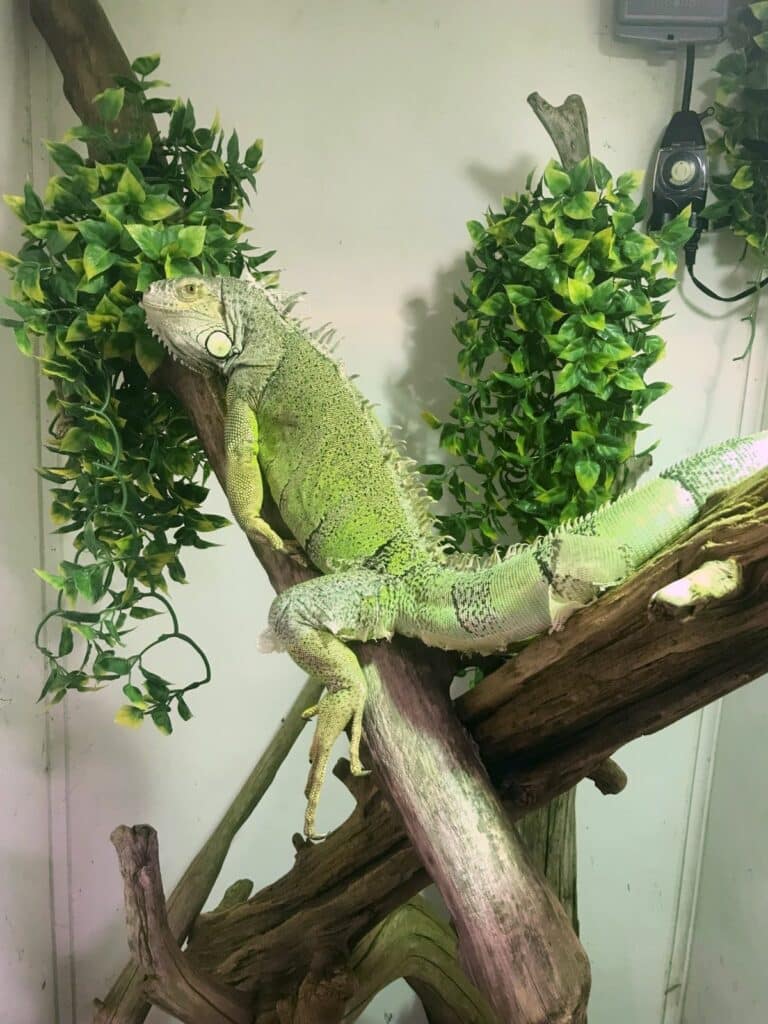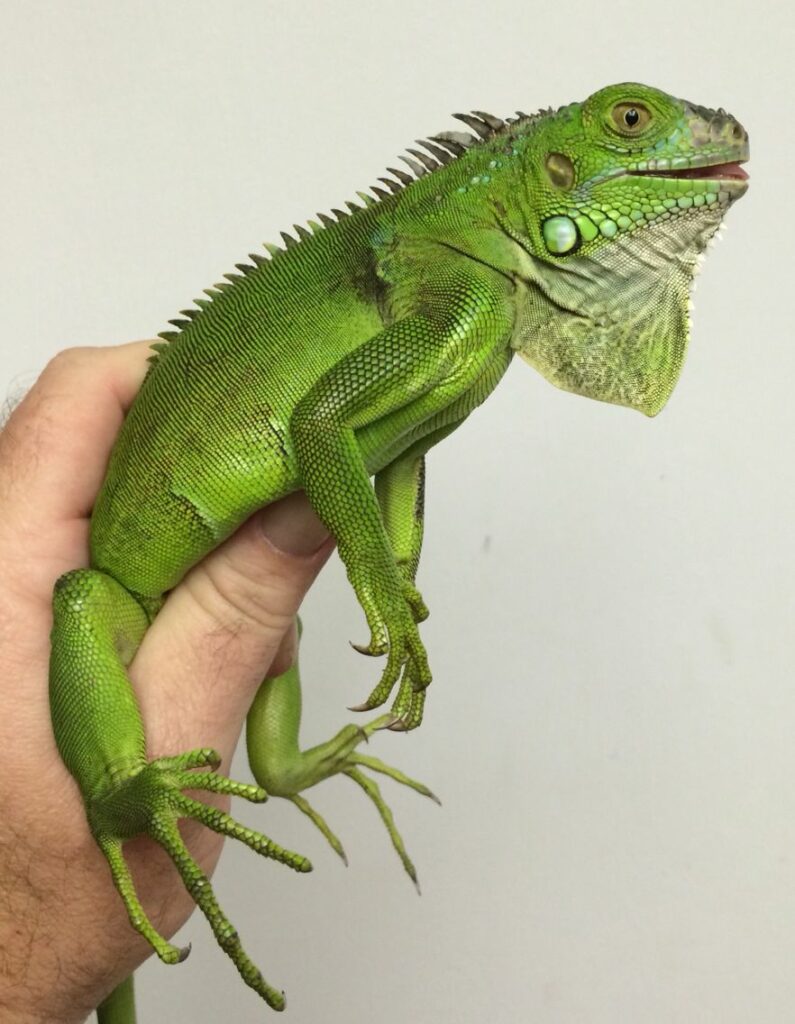An adult green iguana has a prehistoric-look that makes them very distinctive. Reaching up to 6 feet long, these lizards are more like a dog or cat in terms of the space and attention they need.

Iguanas reward keepers with long lives and personalities that you might be surprised reptiles are capable of.
We will be looking in depth at the housing, diet, and lighting requirements of these large lizards. Are you ready for a lizard that needs a small room all to itself and loads of veggies per day?
What is the Green Iguana?
Green iguana pet lizards are a common sight in stores and people’s homes. But this is not always a good thing. Many beginning reptile keepers are unaware of the demands this species will place on you.
Being herbivorous their diet is unlike that of most lizards. And the amount of space an adult green iguana needs makes them suitable only for the most dedicated hobbyist.
But if you provide them with the amount of space and vegetables they need, green iguanas will charm you with their intelligence and personality.
Green iguanas are native to the Americas. They are found from Southern Mexico to Southern Brazil and Paraguay.
Iguanas have been introduced to warm areas throughout the region, however. They now live on many Caribbean islands and warm US states. Green iguanas in Florida and Texas are considered invasive because they disrupt the native species of the region.
In Puerto Rico, where they are also invasive, iguanas are known as the gallina de palo, or “chicken of the tree.” Reminding locals that green iguanas are delicious when prepared with the right seasonings. That said, this guide will focus on pet green iguana care instead of cooking.
How Long Do Green Iguanas Live?
Like many large lizards, green iguanas have a lengthy lifespan and should be thought of as a long-term commitment. 20 years is a typical lifespan for an adult, with occasional records of 25 years also reached.
- Common Names: Common Green Iguana, American Iguana, Gallina de palo
- Scientific Name: Iguana iguana
- Origin: Central & South America
- Length: Up to 6 feet
- Enclosure Size: 12 x 6 x 4 feet
- Diet: Herbivorous
- Green Iguana Lifespan: 20-25 years
- Ease of Care: Moderate
Caring for Green Iguanas as Pets

Iguana green thrive with plenty of space, proper lighting, and a diverse vegetarian diet. Start off right while they are young and you will enjoy your pet iguana for decades to come.
How Big Do Green Iguanas Get?
Iguanas are almost always sold as little lizards around 8 to 12 inches long at local pet stores. An honest employee will warn a beginning hobbyist that a baby iguana will not stay this small forever.
But the majority of employees say nothing. And before long, the baby iguana is either dead from an improper diet or at a rescue facility because it has grown too large.
A full grown green iguana will reach 5 to 6 feet in length, including its massive tail. They will weigh 15-20 lbs as well. Male iguanas are both longer and heavier than females. Iguanas is a species that is sexually dimorphic, meaning you are able to tell the sexes apart visually.
Another way to tell the sexes apart is to examine their head and neck. A male green iguana has a larger dewlap (throat flap). Its jowls are thicker and the ridge of spines running along its backs (dorsal spines) are larger than those of a green iguana female.
These differences aren’t obvious until your green iguana reaches sexual maturity. Full maturity happens by 2 to 3 years of age.
Housing a Green Iguana
The biggest hurdle to caring for a green iguana is the cage size. You want an enclosure that is at least twice the length of a full grown adult. The setup should be 10 to 12 feet long and at least 6 feet wide. The cage should also be 4 to 6 feet high since green iguanas are climbing lizards.
If you live in a warm climate an outdoor enclosure is a great way to give an iguana that space it needs. Natural sunshine also provides the lizard with plenty of infrared and ultraviolet light for metabolic regulation.
Some hobbyists let their green iguana roam the entire house instead. Green iguanas are intelligent enough to be potty trained and are mild tempered once domesticated.
I’d recommend this only if your entire house is iguana-proofed. Meaning anything exposed needs to handle the weight of a 20 lb lizard without breaking. No exposed electric cables to be bitten, either. Dedicating a single room to a pet iguana proofing is what most hobbyists do.
Green Iguana Bath
Green iguanas also like to soak and bathe while drinking. Hatchings and juveniles don’t do this often. Instead, they get their water from misting, licking up small droplets from rocks and leaves. Iguanas also get a lot of their water from the fruits and vegetables they eat.
A water bowl will help maintain humidity in the enclosure. It also helps soften dead skin during sheds. Iguanas also enjoy soaking in water bowls to cool down.
Any water bowl should be large enough for the lizard to fit its entire body in. Even a full grown green iguana likes to bathe.
Iguanas will even poop in their water at times, often during their bath. In the wild, a current would carry feces away. Always be ready to clean out a bowl if an iguana decides to do its business there.
The humidity of the enclosure should stay at 60-75%. As tropical rainforest animals, green iguanas need constant moisture in the air.
Green Iguana Lighting Needs

When designing a green iguana enclosure you also need to think about its lighting needs. Iguanas need visible, heat, and ultraviolet lighting.
The visible light is easy enough. The heat (infrared) wavelengths should come from a ceramic heater set up above the enclosure. The temperature under the bulb should remain at 90-95℉ for comfortable basking.
Ultraviolet radiation in the form of UVb rays is also important. Reptiles need UVb for vitamin D3 synthesis, which regulates calcium uptake. Without it they will suffer from metabolic bone disease. Which is disfiguring at best and fatal at worst.
Certain vitamin powder blends do contain vitamin D3. But these should not be seen as a substitute for proper UVb exposure. It remains to be seen whether a blue green iguana absorbs vitamin D3 from food, like humans do.
What Does the Green Iguana Eat?
Another reason why beginners often don’t succeed with a green iguana is because these lizards are herbivorous. People try to feed iguanas insects, which they will eat small amounts of. But as an exclusive diet, it is fatal over the long term.
A good green iguana diet consists of a broad range of plants. Shredded leafy greens like spinach, endive, kale, and collard are the foundation of their salad.
Mix in chopped and grated veggies like carrot, zucchini, and broccoli. As well as soft fruit like strawberries, grapes, and melon chunks.
Make sure to study the nutritional content of the vegetables you’re offering. For example, certain dark, leafy greens like spinach are high in oxalates.
Raw spinach is healthy and fine as an occasional addition. But if eaten every day oxalates cause kidney stones and interfere with calcium absorption.
Never settle on just a few vegetables; always aim for as much variety as possible. You should also use a calcium and vitamin blend to dust any food you prepare. These powders increase its nutritional content even more.
Here is a video that offers an extensive breakdown of how to prepare a healthy green iguana diet:
Handling a Green Iguana
Taming a green iguana is a process that takes patience and consistency. It is always best to start with a young iguana.
Older iguanas that have not been handled may cause painful injuries through tail slapping, scratches, or bites. They are also harder to train since they know to react with aggression most of the time.
Taming is also a good idea because you will need to move the iguana sometimes to clean its enclosure. A territorial and aggressive green iguana makes this much more difficult.
The first thing to do is to let your new iguana settle into its home for a week or two. Once it has grown accustomed to the enclosure, start with gentle rubs and petting.
Always approach with your hand from the front of the lizard if possible instead of above. Doing so is less intimidating for the iguana.
The green iguana may react with aggression, opening its mouth and puffing up. If you back down too often from an aggressive display, the iguana will remember this. Then it will be harder to train in the future.
These lizards are intelligent and here is where consistency comes into play. Slow, gentle stroking motions for a few minutes are all you need to do. The same applies when cleaning the enclosure; don’t back down if your iguana gets aggressive.
Either continue doing what you are doing or challenge it with gentle petting. Don’t let your iguana use aggression to train you.

Conclusion
Green iguanas are a little more difficult than most pet lizard choices. They have unique dietary restrictions and grow very large.
Iguanas are personable and intelligent. But without training they will become mean and hard to handle. If you are up to the challenge, few reptiles are as satisfying to care for as a tame adult green iguana.
More Frequently Asked Questions About Green Iguanas
Green beans, black beans, kidney beans, and any other sort of bean are excellent additions to a green iguana’s diet. And unlike most beans, green beans can be eaten raw by an iguana. They make a good light snack in between meals.
A green iguana adult will live for 20 to 25 years if well cared for. These lizards are a long-term commitment so think about the space and demands they place on you before buying one.
Tame green iguanas do enjoy being handled. They recognize their owners and like being cradled in your arms. Gentle petting and hand feeding are all part of the pleasure of owning these lizards. You should potty train them so they can wander a large room or your house. Many keepers leash-train their iguana while it explores. Just remember to be watchful as these lizards are fast and strong. They are avid climbers and will scale a piece of furniture or a tree in an instant. A leash makes it easier to recover a climbing green iguana.
